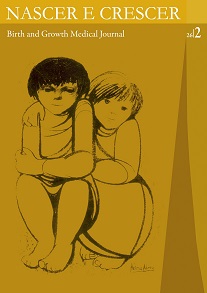EPILEPSY IN CHILDREN – A REPORT FROM A PEDIATRIC OUTPATIENT DEPARTMENT OF A LEVEL II HOSPITAL
DOI:
https://doi.org/10.25753/BirthGrowthMJ.v26.i2.10090Keywords:
Crisis, epilepsy, pediatricAbstract
Introduction and Objectives: Epilepsy represents one of the most frequent neurologic diseases in children and adolescents, with a prevalence of four to six cases per 1000 children. The aim of the present study is to analyze clinical and epidemiological characteristics of patients with epilepsy followed in a pediatric outpatient department of a level II hospital.
Methods: Retrospective review of the clinical files of patients followed in a pediatric-neurologic diseases consultation between May 2009 and June 2014. The epileptic seizures were classified according to the International League Against Epilepsy.
Results: The study included 42 patients, 54.8% males, with a median age at diagnosis of 78 months (IQR 5-205). Four children (9.5%) had a history of prematurity, three (7.1%) needed resuscitation maneuvers after birth, one (2.4%) had a previous neurologic impairment and three (7.1%) had a history of febrile seizures. Family history of epilepsy was positive in 53.7% of cases. Seizure types were generalized in 60% of the children, predominantly tonic-clonic. After the first seizure, 98% of children performed electroencephalography, that was abnormal in 69% of the cases and in these patients treatment was initiated with anti-epileptic drugs. The brain imaging was performed in 27 patients (64.3%) and was abnormal in four (15.4%). Of the 42 patients, half had new seizures. Because they had recurrent seizures, it was necessary to add a new anti-epileptic drug in seven children (16.7%). Morbidities were detected in 30% of children, especially cognitive impairment (21.4%).
Conclusion: The clinical history and the electroencephalography are essential for the diagnosis of epilepsy. The prognosis is good in most children. Longitudinal studies should be planned in order to determine the national incidence of epilepsy in children and its characteristics.
Downloads
References
Cowan L, Bodensteiner JB, Levviton A, Doherty L. Prevalence
of the epilepsies in children and adolescents. Epilepsia.
; 30: 94-106.
Serdarog˘lu A,O¨ zkan S, Aydın K, et al. Prevalence of
epilepsy in Turkish children between the ages of 0 and 16
years. J Child Neurol. 2004;19:271-4.
Waaler PE, Blom BH, Skeidsvoll H, Mykletun A. Prevalence,
classification, and severity of epilepsy in children in Western
Norway. Epilepsia. 2000; 41:802-10.
Larsson K, Eeg-Olofsson O. A population based study of
epilepsy in children from a Swedish county. Eur J Pediatr
Neurol. 2006; 10:107-13.
Fisher RS et al. Epileptic seizures and epilepsy: definitions
proposed by the International League Against Epilepsy (ILAE)
and the International Bureau for Epilepsy (IBE). Epilepsia
; 46:470-2.
Instituto Nacional de Estatística. Censos 2011 Resultados
Definitivos – Portugal. 2011. (Acedido em 11 de dezembro
de 2016). Disponível em: censos.ine.pt/.
Shorvon S. The etiologic classification of epilepsy. Epilepsia
; 52: 1052-7.
Fisher RS et al. A practical clinical definition of epilepsy.
Epilepsia 2014; 55:475–82.
Sidenvall R, Forsgren L, Blomquist HK, et al. A communitybased
prospective incidence study of epileptic seizures in
children. Acta Paediatr 1993; 82:60–65.
Hauser WA, Annegers JF, Kurland LT. Incidence of epilepsy
and unprovoked seizures in Rochester, Minnesota: 1935-
Epilepsia. 1993; 34:453–68.
Jallon P, Goumaz M, Haenggeli C, et al. Incidence of first
epileptic seizures in the canton of Geneva, Switzerland.
Epilepsia. 1997; 38:547–52.
Kurtz Z, Tookey P, Ross E. 1998. Epilepsy in young people:
year follow up of the British National Child Development
Study. BMJ 316:339–42.
Cowan LD. The epidemiology of the epilepsies in children.
Ment Retard Dev Disabil Res Rev 2002; 8:171-81
Panayiotopoulos CP. General aspects of epilepsies. In:
Panayiotopoulos CP, ed. A Clinical Guide to Epileptic
Syndromes and Their Treatment. London: Springer;
Freitag CM, TheodorWM, Pfäfflin M, et al. Incidence
of epilepsies and epileptic syndromes in children and
adolescents: a population-based prospective study in
Germany. Epilepsia. 2001; 42:979-85.
Ünver O, Keskin SP, Uysal S, Ünver A. The epidemiology
of epilepsy in children: a report from a Turkish pediatric
neurology clinic. HYPERLINK “https://www.ncbi.nlm.nih.
gov/pubmed/25038132”J Child Neurol. 2015; 30:698-702.
doi: 10.1177/0883073814539559. Epub 2014 Jul 17.
Kwong KL, Chak WK, Wong SN, So KT. Epidemiology of
Childhood Epilepsy in a Cohort of 309 Chinese Children.
Pediatr Neurol 2001; 24:276-82.
Cavazzuti GB. Epidemiology of different types of epilepsy
in school age children of Modena, Italy. Epilepsia. 1980;
:57-62.
Leary PM, Morris S. Recurrent seizures in childhood. Western
Cape profile. S Afr Med J. 1988; 74:579-81.
Winckler M, Rotta N. Clinical and Electroencephalographic
follow-up after a first unprovoked seizure. Pediatr Neurol.
; 30:201-6.
Fondation Française pour la Recherche sur l’Epilepsie.
Epilepsies and time to diagnosis: Descriptive results of the
CAROLE survey. Rev Neurol (Paris). 2000; 156:481-90.
Camfield P, Camfield C. Incidence, prevalence and aetiology
of seizures and epilepsy in children. Epileptic Disord. 2015;
:117-23.
Endziniene M, Pauza V, Mizeviciene I. Prevalence of epilepsy
in Kaunas, Lithuania. Brain Dev 1997; 19:379-87.
Downloads
Published
How to Cite
Issue
Section
License
Copyright and Authors' Rights
All articles published in Nascer e Crescer - Birth and Growth Medical Journal are Open Access and comply with the requirements of funding agencies or academic institutions. For use by third parties, Nascer e Crescer - Birth and Growth Medical Journal adheres to the terms of the Creative Commons License "Attribution - Non-Commercial Use (CC-BY-NC)".
It is the author's responsibility to obtain permission to reproduce figures, tables, etc. from other publications.
Authors must submit a Conflict of Interest statement and an Authorship Form with the submission of the article. An e-mail will be sent to the corresponding author confirming receipt of the manuscript.
Authors are permitted to make their articles available in repositories at their home institutions, provided that they always indicate where the articles were published and adhere to the terms of the Creative Commons license.


